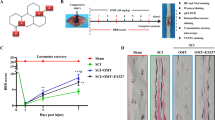Abstract
Autophagy occurs prior to apoptosis and plays an important role in cell death regulation during spinal cord injury (SCI). This study aimed to determine the effects and potential mechanism of the glucagon-like peptide-1 (GLP-1) agonist extendin-4 (Ex-4) in SCI. Seventy-two male Sprague Dawley rats were randomly assigned to sham, SCI, 2.5 μg Ex-4, and 10 μg Ex-4 groups. To induce SCI, a 10-g iron rod was dropped from a 20-mm height to the spinal cord surface. Ex-4 was administered via intraperitoneal injection immediately after surgery. Motor function evaluation with the Basso Beattie Bresnahan (BBB) locomotor rating scale indicated significantly increased scores (p < 0.01) in the Ex-4-treated groups, especially 10 μg, which demonstrated the neuroprotective effect of Ex-4 after SCI. The light chain 3-II (LC3-II) and Beclin 1 protein expression determined via western blot and the number of autophagy-positive neurons via immunofluorescence double labeling were increased by Ex-4, which supports promotion of autophagy (p < 0.01). The caspase-3 protein level and neuronal apoptosis via transferase UTP nick end labeling (TUNEL)/NeuN/DAPI double labeling were significantly reduced in the Ex-4-treated groups, which indicates anti-apoptotic effects (p < 0.01). Finally, histological assessment via Nissl staining demonstrated the Ex-4 groups exhibited a significantly greater number of surviving neurons and less cavity (p < 0.01). To our knowledge, this is the first study to indicate that Ex-4 significantly enhances motor function in rats after SCI, and these effects are associated with the promotion of autophagy and inhibition of apoptosis.






Similar content being viewed by others

References
Varma AK, Das A, Wallace G IV et al (2013) Spinal cord injury: a review of current therapy, future treatments, and basic science frontiers[J]. Neurochem Res 38(5):895–905
Rabchevsky AG, Patel SP, Springer JE (2011) Pharmacological interventions for spinal cord injury: where do we stand? How might we step forward?[J]. Pharmacol Ther 132(1):15–29
Park Y, Liu C, Luo T et al (2015) Chaperone-mediated autophagy after traumatic brain injury[J]. J Neurotrauma
Leber B, Andrews DW (2010) Closing in on the link between apoptosis and autophagy[J]. F1000 biology reports. 2
Kanno H, Ozawa H, Sekiguchi A et al (2012) The role of mTOR signaling pathway in spinal cord injury[J]. Cell Cycle 11(17):3175–3179
Sun LQ, Gao JL, Cui Y et al (2015) Neuronic autophagy contributes to p-connexin 43 degradation in hippocampal astrocytes following traumatic brain injury in rats[J]. Mol Med Rep 11(6):4419–4423
Sandoval D, Sisley SR (2015) Brain GLP-1 and insulin sensitivity[J]. Mol Cell Endocrinol Newsl
Li Y, Chigurupati S, Holloway HW et al (2012) Exendin-4 ameliorates motor neuron degeneration in cellular and animal models of amyotrophic lateral sclerosis[J]. PLoS One 7(2):e32008
Yamamoto K, Amako M, Yamamoto Y et al. (2013) Therapeutic effect of exendin-4, a long-acting analogue of glucagon-like peptide-1 receptor agonist, on nerve regeneration after the crush nerve injury[J]. Biomed Res Int. 2013
Holscher C (2010) Incretin analogues that have been developed to treat type 2 diabetes hold promise as a novel treatment strategy for Alzheimer's disease[J]. Recent Pat CNS Drug Discov 5(2):109–117
Wang LX, Wang YP, Chen Z et al (2010) Exendin-4 protects murine pancreatic β-cells from dexamethasone-induced apoptosis through PKA and PI-3K signaling[J]. Diabetes Res Clin Pract 90(3):297–304
Abe H, Uchida T, Hara A et al (2013) Exendin-4 improves β-cell function in autophagy-deficient β-cells[J]. Endocrinology 154(12):4512–4524
Hu JZ, Long H, Wu TD et al (2015) The effect of estrogen-related receptor α on the regulation of angiogenesis after spinal cord injury[J]. Neuroscience 290:570–580
Basso DM, Beattie MS, Bresnahan JC (1995) A sensitive and reliable locomotor rating scale for open field testing in rats[J]. J Neurotrauma 12(1):1–21
Kanno H, Ozawa H, Sekiguchi A et al (2011) Induction of autophagy and autophagic cell death in damaged neural tissue after acute spinal cord injury in mice[J]. Spine 36(22):E1427–E1434
Seo JY, Kim YH, Kim JW et al. (2015) Effects of Therapeutic Hypothermia on Apoptosis and Autophagy following Spinal Cord Injury in Rats[J]. Spine.
Fulda S, Kögel D (2015) Cell death by autophagy: emerging molecular mechanisms and implications for cancer therapy [J]. Oncogene.
Kara H, Degirmenci S, Ak A et al. (2014) Neuroprotective effects of sildenafil in experimental spinal cord injury in rabbits [J]. Bosn J Basic Med Sci. 15(1).
Kang R, Zeh HJ, Lotze MT et al (2011) The Beclin 1 network regulates autophagy and apoptosis[J]. Cell Death Differ 18(4):571–580
Wang ZY, Lin JH, Muharram A et al (2014) Beclin-1-mediated autophagy protects spinal cord neurons against mechanical injury-induced apoptosis[J]. Apoptosis 19(6):933–945
Teramoto S, Miyamoto N, Yatomi K et al (2011) Exendin-4, a glucagon-like peptide-1 receptor agonist, provides neuroprotection in mice transient focal cerebral ischemia[J]. J Cereb Blood Flow Metab 31(8):1696–1705
Rangaraju S, Verrier JD, Madorsky I et al (2010) Rapamycin activates autophagy and improves myelination in explant cultures from neuropathic mice[J]. J Neurosci 30(34):11388–11397
Sekiguchi A, Kanno H, Ozawa H et al (2012) Rapamycin promotes autophagy and reduces neural tissue damage and locomotor impairment after spinal cord injury in mice[J]. J Neurotrauma 29(5):946–956
Li L, Tan J, Miao Y, et al. (2015)ROS and Autophagy: interactions and molecular regulatory mechanisms [J]. Cell Mol Neurobiol.1-7
Vaquero J, Zurita M, Oya S et al. (2006) Early administration of methylprednisolone decreases apoptotic cell death after spinal cord injury [J].
Li Z, Zhou Z, Huang G et al (2013) Exendin-4 protects mitochondria from reactive oxygen species induced apoptosis in pancreatic Beta cells[J]. PLoS One 8(10):e76172
Acknowledgments
This research was supported by the National Natural Science Foundation of China (Grant No. 81272074); the Program for Liaoning Excellent Talents in University (Grant No. 2014091); and the Aohongboze Graduate Sci-tech Innovation Foundation, the President Fund of Liaoning Medical University (Grant No. AH2014012).
Conflict of Interest
The authors declare that they have no competing interests.
Author information
Authors and Affiliations
Corresponding authors
Rights and permissions
About this article
Cite this article
Li, HT., Zhao, XZ., Zhang, XR. et al. Exendin-4 Enhances Motor Function Recovery via Promotion of Autophagy and Inhibition of Neuronal Apoptosis After Spinal Cord Injury in Rats. Mol Neurobiol 53, 4073–4082 (2016). https://doi.org/10.1007/s12035-015-9327-7
Received:
Accepted:
Published:
Issue Date:
DOI: https://doi.org/10.1007/s12035-015-9327-7



